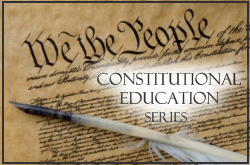 It’s important that we educate our children on the topics of politics, government, and the Constitution which governs our nation. This nine-part series attempts to remind us of some basic principles, lest they be forgotten by the next generation.
It’s important that we educate our children on the topics of politics, government, and the Constitution which governs our nation. This nine-part series attempts to remind us of some basic principles, lest they be forgotten by the next generation.Late in the year 1800, John Adams was narrowly defeated in the presidential election by Thomas Jefferson. In an effort to “pack the courts” with Federalist judges of his own thinking, Adams made dozens of judicial appointments just before he left office (these were called “midnight appointments”). To complete the appointment, a nominee had to be both approved by Congress and have their commission signed by the Secretary of State.
Due to a curious oversight, a few of the appointees never had their commission signed under the outgoing administration, and were left waiting for the signature of the new Secretary, James Madison. One of these pending appointees was William Marbury. So began the famous Marbury vs. Madison court case.
Madison refused to sign the commission, and Marbury sued, immediately taking his case to the Supreme Court. He contended that under the Judiciary Act of 1789, Madison should be forced to sign his commission – that a writ of mandamus should be written by the court requiring him to do so. Ultimately, the Supreme Court agreed that Marbury should be appointed, but that the Judiciary Act law that he was citing was really unconstitutional, and that he should take his case back to a lower court.
Marbury lost the case, but the real story here was that the Supreme Court, for the first time, had single-handedly declared an Act of Congress to be unconstitutional. In essence, the Court asserted authority over Congress in an unprecedented manner, essentially giving itself the supreme right to interpret the Constitution. To us today, that may not seem like big news, but the fact is that the Constitution does not anywhere give the Supreme Court this power! Article 3 of the Constitution details the jurisdiction and duties of the Supreme Court, and indeed, Section 2 seems to imply that Marbury may have been in the wrong court. But the brazenness of Chief Justice John Marshall to unilaterally strike down an Act of Congress was unheard of before this event (and curiously, John Marshall was the Secretary of State in the Adams administration who had accidentally forgotten to sign Marbury’s commission before being appointed Chief Justice!)
Thomas Jefferson was incensed at the judicial ruling, and wrote, “Certainly there is not a word in the Constitution which has given that power to them more than to the Executive or Legislative branches.” For Jefferson, the founders intended for the three branches of government to be in equal balance, with no single branch having supreme authority to interpret the Constitution.
With a precedent such as Marbury vs. Madison on the record, that precept has been lost. Today, we live in a time where it is generally accepted that the United States Supreme Court is the ultimate arbiter of the Constitution, with the authority to rescind or make demands on both the Congress and the President. But a simple reading of the Constitution shows that no such power was meant. This was the beginning of judicial activism.
Judicial activists submit that the Constitution is a “living document” and that powers and nuances not mentioned explicitly in the text may be “implied”. The opposite of this position is judicial restraint, which argues for a very conservative approach to rulings. A judge exercising judicial restraint will overturn a law only if it is obviously unconstitutional. In the case of Marbury, judicial restraint would likely have found a judge simply sending the case back with no ruling, rather than explicitly declaring the law unconstitutional. An advocate of judicial restraint, Ronald Reagan said “I intend to go right on appointing highly qualified individuals of the highest personal integrity to the bench, individuals who understand the danger of short-circuiting the electoral process and disenfranchising the people through judicial activism."
Judicial activism has grown beyond just the assertion of supreme constitutional authority. Today, we see many judges making rulings based on their own opinion, and not citing a legal precedence. Roe vs. Wade is probably the most far-reaching example of judicial activism. In this case, the Supreme Court cited the “right to privacy” to allow a woman to terminate her own pregnancy, but admitted in their own written ruling that “The Constitution does not explicitly mention any right of privacy." If judges are allowed to make laws with no Constitutional backing or precedent, then what happens to justice? Rather than relying on the written Constitution to govern our land, it becomes a matter of individual opinion, and the court system becomes nothing more than a game of “packing the courts” with judges who are sympathetic to an individual cause. This makes a mockery of justice, and undermines the real intent of the founders when they penned that most important document – the Constitution of the United States of America.
**********************
Next in the series
-or-
Back to the main index article.
...











No comments:
Post a Comment